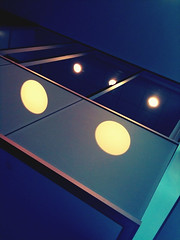In Defense of Instagram

This is cross-posted from my blog at Tin Lizard Productions.
A few days ago, Roger Ebert posted on his blog that he didn’t think that the ubiquitousness of Internet-armed cameras was a good thing:
I find this news concerning because it results in a degradation of the art of photography. … [Camera users] are performing a social ritual, and little of what results is worth saving or seeing.
The infographic he provides is very interesting, but I think Mr. Ebert’s opinion is extremely short-sighted.
A camera is a tool. A computer is a tool. PhotoShop, 3D modeling software, and mobile phones are all tools. The quality of the tool might slightly alter the results the wielder gets from it, but there is nothing inherently bad or good about any of these items. Those cheapo plastic paintbrushes that come with kids’ watercolor sets are ubiquitous and pretty horrible as far as paintbrushes go, but I’m guessing that you’d still get a decent painting back if you handed one of those brushes to Michelangelo.
In my opinion, about 80% of all art created is crap. It’s not necessarily invaluable crap, but still… crap. It’s amateur or poorly conceived or banal or badly executed… whatever. We can quibble about the number before the percent sign, but the number isn’t the point. The point is that, whatever that percentile is, it’s constant. You could have 100 photographers in the world or 1 million, but regardless, 80% of what they make will be crap. Will 1 million photographers make more crap than 100 photographers? Absolutely. They can drown the world in crap photos. But if there’s even just one Ansel Adams in the group of 100 photographers, there could be 10,000 Ansel Adamses in the group of 1 million.
There are 7 billion people on this planet, and now more people than ever have easy, cheap access to a camera. Sure, there’s a lot of bad photography going on, but there’s also more good photography than ever before. That’s just a question of volume and scaling.
Here are some other reasons why I think camera phones are a great thing:
- The best camera is the one you have with you: I haven’t weighed my Sony DSLR, but it’s one big, heavy piece of equipment, that also requires other big, heavy pieces of equipment to work to its full potential. My camera gear collection is relatively modest, but it still fills a backpack. I only grab that backpack when I’m planning to do photography. By contrast, my iPhone is with me everywhere, because it fits in my pocket. If I see a Monarch caterpillar while I’m walking on a workday break, the iPhone is what I’ll need to use.
. - An affordable one-stop shop: A smartphone isn’t necessarily cheap. However, it is far cheaper than buying a standalone camera (even a point-and-shoot) plus the computer required to edit and upload photos. My DSLR is worth about $2k, my Mac laptop cost around the same, and a copy of Aperture is $100. My iPhone cost $200, and it not only shoots photos, but it can also edit, catalog, and post them.
. - Cameras of quality:Today’s phones come with cameras of vastly different qualities, but many are actually decent digital cameras. My iPhone has a better camera than could be obtained as a point-and-shoot even just a few years ago, and it’s far better than my first pro-quality digital camera. Plus, it has a nearly unlimited amount of focus points, which, in terms of focus selection, makes it better than even my current DSLR.
. - Building the conversation: Even though I visited the Galapagos Islands around four years ago — ancient history, in Internet terms — I still get e-mails about them. Even my lackluster images have drawn interest from scientists and science students, who often need Creative Commons images to flesh out their papers or presentations. You never know what will be valuable to people you have never met.
. - Sometimes, it’s the best tool for the job: There are times when I’ve had my DSLR camera with me, and I chose to use my iPhone instead. My iPhone can fit into nooks and crannies that my DSLR cannot. My iPhone’s lens can get within a centimeter of the ground and aim at any angle, and my DSLR cannot. I can point and shoot with my iPhone faster than I can with my DSLR.
. - Personality: This one is specifically aimed at Instagram, Hipstamatic, and other smartphone photo filters. I remember the days of cassette tapes, when I had a Mr. Bungle tape which once got caught in the player and then rescued. From that day forth, a couple of tracks had distinct noises made by the crinkled tape. That wasn’t part of the music recorded my Mr. Bungle, but those noises became a part of how I perceived that music. Nobody else’s tape sounded like that. In this digital age, every photo can be transmitted with perfect fidelity. No more dog-eared, faded photos in photo albums. Photos like that have a lived-in quality. Sure, applying an Instagram filter isn’t the same as giving a photo a life in the real world, but it does add a touch of personality, because you, the photo’s creator, chose to add that final touch. Even though there is a certain sameness to Instagram photos, they also contain a certain warmth.
You can take an award-winning photo with an iPhone camera just as well as you can take one with a DSLR. The things that make a great photo come from the photographer, not the camera itself.
Want to rock that camera phone? There’s plenty of advice out there (just Google “iPhonetography”, regardless of the brand of phone you have), but here are my favorite tips:
- Know your equipment: For reasons I covered above, it doesn’t matter if you can’t afford the latest and greatest camera. Just know what it can do, and experiment with it. There’s a reason why many photography nerds seek out Holga cameras, with their terrible plastic lenses and light leaks: those cameras have quirks that no other cameras have. Use the hell out of your camera. Test its limits. Find its quirks and turn them into an asset.
. - Pay attention to edges and negative space: I can say a million things about image composition, but much of it boils down to this. Train yourself to see negative space, and with each image, think about the shapes that negative space makes with the edges of your photo. Many times, you can get a much more interesting photo just by moving the camera to a slightly different angle, to make that negative space work.
. - Edit, edit, EDIT: If you really want to look like a brilliant photographer (or artist of any stripe), post only your best work. If you shoot a hundred photos, post only your five best. This is what the pros do. Pros shoot thousands of crappy photos that you will never see. Don’t post a dozen variations of the same shot. Don’t post an image that didn’t really work, but you thought it might work while you were shooting it. Don’t post that photo that just looks half-assed. Just post the good stuff. You don’t have to trash everything else. Just don’t broadcast it to the world.
Note: The three images posted above were all shot by me on an iPhone.
Top: Downtown Minneapolis, shot with Instagram on an iPhone 4s.
Middle: A glass bead, shot with a iPhone 3Gs, augmented with a macro lens I made out of cardboard and a plastic lens from a Laserdisc player.
Bottom: A meeting room at my workplace, shot with a 3Gs.




“The best camera is the one you have with you”
Absolutely!
Though on the flip side … I’ve found that owning a smartphone means that I’m less and less likely to bring my camera along with me (though having no talent for photography whatsoever, the world really isn’t any poorer for it).
I don’t think phography’s greatest contribution is art. It can certainly BE great art, but to the vast majority of us, its importance is that ‘social ritual’ that Ebert seems to deride — producing content that means something to us personally, even if no one else wants to watch our vacation slideshows.
My point being … I create my poorly cropped Hipstamatic pet photos for no one but me, and Ebert can suck it. 🙂
Great point, quarksparrow! Art in itself is essentially about communication, but perhaps photography is even more about communication than most breeds of art, especially in this brave new digital world. Hmm, something to ponder!
I have to agree with this article.
I graduated with a Bachelors degree in photography in 2010 and then went into a creative slump. After working my butt off to put together a portfolio and working hours to carefully edit my graduation exhibition I found I had burnt myself out. With access to magnificent equipment and no boundaries on what I could create, I found I didn’t want to create anything.
Instagram has started to turn this around. Getting the best image I can within the limitations of my iPod touch and the various editing apps has made me excited about taking images again. They might not be to the professional standard I previously held myself to, and I may not spend 10 hours photoshopping them, but they are precious snapshots that remind me why I started photography to begin with.